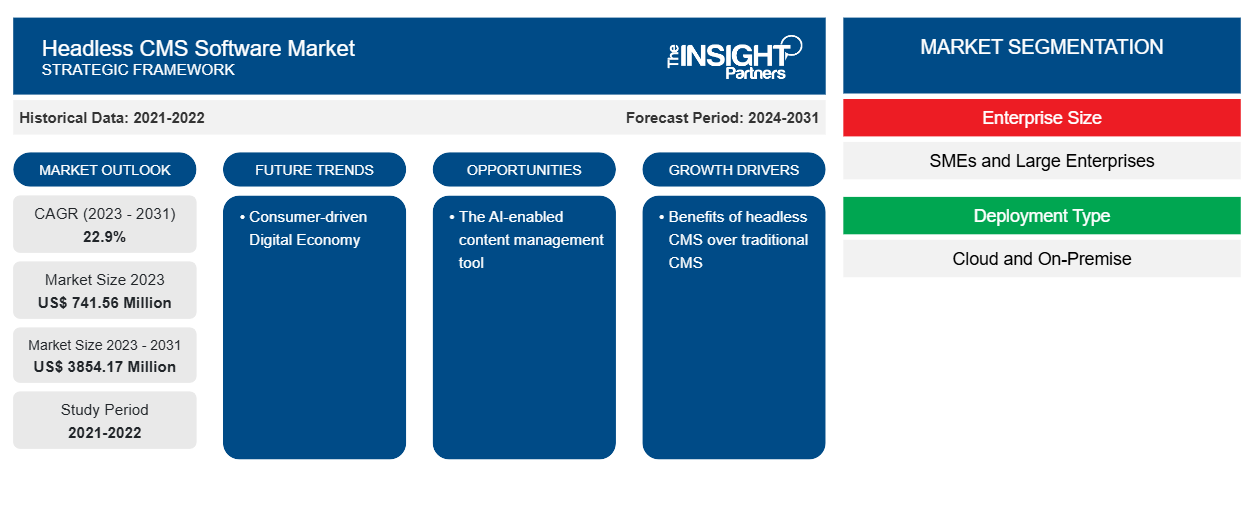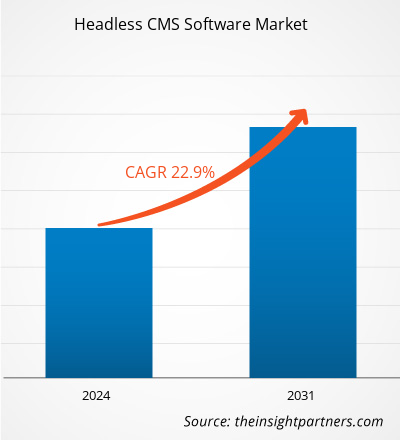Headless CMS Software Market Key Players and Forecast by 2031
Historic Data: 2021-2022 | Base Year: 2023 | Forecast Period: 2024-2031Headless CMS Software Market Size and Forecast (2021 - 2031), Global and Regional Share, Trend, and Growth Opportunity Analysis Report Coverage: By Deployment Type (Cloud and On-Premise), Enterprise Size (SMEs and Large Enterprises), and Geography
- Report Date : Feb 2026
- Report Code : TIPRE00015372
- Category : Technology, Media and Telecommunications
- Status : Data Released
- Available Report Formats :


- No. of Pages : 150
The headless CMS software market size is projected to reach US$ 3854.17 million by 2031 from US$ 741.56 million in 2023. The market is expected to register a CAGR of 22.9% in 2023–2031. The rapid growth of digital content and the adoption of cloud-based technologies are likely to remain key to headless CMS software market trends.
Headless CMS Software Market Analysis
Adoption of headless CMS software leads to improved security and performance, and headless CMS may promote flexibility, scalability, and localization. This factor drives the headless CMS software market. The demand for headless CMS across various industries in developed and developing countries propels its market growth.
Headless CMS Software Market Overview
A headless CMS is a content management system that allows you to separate the front end from the back end. A CMS serves as a content repository in this architecture, and the content can be deployed on multiple platforms via an API. One of the primary benefits of headless CMS is its flexibility. With a traditional CMS, the frontend and backend are inextricably linked, so changes to the frontend affect changes to the backend, and vice versa. With headless CMS, the backend is separated from the frontend, allowing businesses to change their content and applications on the frontend without affecting the backend.
Customize This Report To Suit Your Requirement
You will get customization on any report - free of charge - including parts of this report, or country-level analysis, Excel Data pack, as well as avail great offers and discounts for start-ups & universities
Headless CMS Software Market: Strategic Insights

-
Get Top Key Market Trends of this report.This FREE sample will include data analysis, ranging from market trends to estimates and forecasts.
Headless CMS Software Market Drivers and Opportunities
Consumer-driven Digital Economy to Favor Market
The consumer-driven digital economy has become the fundamental component of digital commerce strategies across industries. The consumer reaches companies or brands via a number of channels. This encourages companies to modernize their digital experience strategy to deliver true omnichannel experiences to meet the personalization demands of customers. Customer-centric content needs to be personalized, dynamic, and delivered at great speed. With the benefits of agility, flexibility, scalability, and personalization, headless CMS software can help companies enhance the customer experience.
Benefits of headless CMS over traditional CMS
A headless CMS offers greater flexibility over traditional CMS, as with the headless CMS, the content needs to be created once. It can be distributed to multiple channels and devices, including websites, smartwatches, mobile apps, IoT devices, and others. Headless CMS delivers content via APIs where the pages load at a greater speed more efficiently, whereas with the traditional CMS, each page requires trigger a server-side-render, which causes slow load time. Headless CMS is more secure than traditional CMS as they use advanced cloud-native technologies and they don’t expose the backend server to the internet. Thus, such several benefits of headless CMS over traditional CMS lead to the headless CMS software market growth.
Headless CMS Software Market Report Segmentation Analysis
Key segments that contributed to the derivation of the headless CMS software market analysis are ink deployment, organization size, monitoring type, and industry.
- By deployment, the market is segmented into on-premise and cloud. The cloud segment is expected to grow with the highest CAGR.
- Based on the enterprise size, the market is segmented into SMEs and large enterprises. The SMEs segment is expected to grow with the highest CAGR.
Headless CMS Software Market Share Analysis by Geography
The geographic scope of the headless CMS software market report is mainly divided into five regions: North America, Asia Pacific, Europe, Middle East & Africa, and South America/South & Central America.
Asia Pacific region is expected to grow with the highest CAGR. The proliferation of cloud technology in the region leads to the region’s market growth. The growing SMEs in the region fuel the demand for software solutions in the region, driving the use of synthetic monitoring technology. Digital transformation in emerging economies such as India and China leads to the adoption of synthetic monitoring solutions in various end-user industries.
Headless CMS Software Market Regional InsightsThe regional trends and factors influencing the Headless CMS Software Market throughout the forecast period have been thoroughly explained by the analysts at The Insight Partners. This section also discusses Headless CMS Software Market segments and geography across North America, Europe, Asia Pacific, Middle East and Africa, and South and Central America.
Headless CMS Software Market Report Scope
| Report Attribute | Details |
|---|---|
| Market size in 2023 | US$ 741.56 Million |
| Market Size by 2031 | US$ 3854.17 Million |
| Global CAGR (2023 - 2031) | 22.9% |
| Historical Data | 2021-2022 |
| Forecast period | 2024-2031 |
| Segments Covered |
By Enterprise Size
|
| Regions and Countries Covered |
North America
|
| Market leaders and key company profiles |
|
Headless CMS Software Market Players Density: Understanding Its Impact on Business Dynamics
The Headless CMS Software Market is growing rapidly, driven by increasing end-user demand due to factors such as evolving consumer preferences, technological advancements, and greater awareness of the product's benefits. As demand rises, businesses are expanding their offerings, innovating to meet consumer needs, and capitalizing on emerging trends, which further fuels market growth.

- Get the Headless CMS Software Market top key players overview
Headless CMS Software Market News and Recent Developments
The Headless CMS Software Marketis evaluated by gathering qualitative and quantitative data post primary and secondary research, which includes important corporate publications, association data, and databases. The following is a list of developments in the market:
- In June 2023, aurastride, the latest addition to the Vsourz product offering, is aiming to disrupt the travel industry with its launch as a cutting-edge headless CMS platform. This innovative solution is set to transform the way travel businesses manage content and deliver personalized experiences, while also offering a seamless integration with the highly acclaimed moonstride travel industry SAAS platform. (Source: moonstride, Press Release, 2023)
Headless CMS Software Market Report Coverage and Deliverables
The “Headless CMS Software Market Size and Forecast (2021–2031)” report provides a detailed analysis of the market covering below areas:
- Market size and forecast at global, regional, and country levels for all the key market segments covered under the scope
- Market dynamics such as drivers, restraints, and key opportunities
- Key future trends
- Detailed PEST/Porter’s Five Forces and SWOT analysis
- Global and regional market analysis covering key market trends, major players, regulations, and recent market developments
- Industry landscape and competition analysis covering market concentration, heat map analysis, prominent players, and recent developments
- Detailed company profiles
Frequently Asked Questions
What is the estimated market size for the global headless CMS software market in 2023?
What are the driving factors impacting the global headless CMS software market?
What are the future trends of the global headless CMS software market?
Which are the key players holding the major market share of the global headless CMS software market?
What will be the market size of the global headless CMS software market by 2031?
What is the incremental growth of the global headless CMS software market during the forecast period?
Ankita is a dynamic market research and consulting professional with over 8 years of experience across the technology, media, ICT, and electronics & semiconductor sectors. She has successfully led and delivered 100+ consulting and research assignments for global clients such as Microsoft, Oracle, NEC Corporation, SAP, KPMG, and Expeditors International. Her core competencies include market assessment, data analysis, forecasting, strategy formulation, competitive intelligence, and report writing.
Ankita is adept at handling complete project cycles—from pre-sales proposal design and client discussions to post-sales delivery of actionable insights. She is skilled in managing cross-functional teams, structuring complex research modules, and aligning solutions with client-specific business goals. Her excellent communication, leadership, and presentation abilities have enabled her to consistently deliver value-driven outcomes in fast-paced and evolving market environments.
- Historical Analysis (2 Years), Base Year, Forecast (7 Years) with CAGR
- PEST and SWOT Analysis
- Market Size Value / Volume - Global, Regional, Country
- Industry and Competitive Landscape
- Excel Dataset
Recent Reports
Related Reports
Testimonials
The Insight Partners' SCADA System Market report is comprehensive, with valuable insights on current trends and future forecasts. The team was highly professional, responsive, and supportive throughout. We are very satisfied and highly recommend their services.
RAN KEDEM Partner, Reali Technologies LTDsI requested a report on a very specific software market and the team produced the report in a few days. The information was very relevant and well presented. I then requested some changes and additions to the report. The team was again very responsive and I got the final report in less than a week.
JEAN-HERVE JENN Chairman, Future AnalyticaWe worked with The Insight Partners for an important market study and forecast. They gave us clear insights into opportunities and risks, which helped shape our plans. Their research was easy to use and based on solid data. It helped us make smart, confident decisions. We highly recommend them.
PIYUSH NAGPAL Sr. Vice President, High Beam GlobalThe Insight Partners delivered insightful, well-structured market research with strong domain expertise. Their team was professional and responsive throughout. The user-friendly website made accessing industry reports seamless. We highly recommend them for reliable, high-quality research services
YUKIHIKO ADACHI CEO, Deep Blue, LLC.This is the first time I have purchased a market report from The Insight Partners.While I was unsure at first, I visited their web site and felt more comfortable to take the risk and purchase a market report.I am completely satisfied with the quality of the report and customer service. I had several questions and comments with the initial report, but after a couple of dialogs over email with their analyst I believe I have a report that I can use as input to our strategic planning process.Thank you so much for taking the extra time and making this a positive experience.I will definitely recommend your service to others and you will be my first call when we need further market data.
JOHN SUZUKI President and Chief Executive Officer, Board Director, BK TechnologiesI wish to appreciate your support and the professionalism you displayed in the course of attending to my request for information regarding to infectious disease IVD market in Nigeria. I appreciate your patience, your guidance, and the fact that you were willing to offer a discount, which eventually made it possible for us to close a deal. I look forward to engaging The Insight Partners in the future, all thanks to the impression you have created in me as a result of this first encounter.
DR CHIJIOKE ONYIA MANAGING DIRECTOR, PineCrest Healthcare Ltd.Reason to Buy
- Informed Decision-Making
- Understanding Market Dynamics
- Competitive Analysis
- Identifying Emerging Markets
- Customer Insights
- Market Forecasts
- Risk Mitigation
- Boosting Operational Efficiency
- Strategic Planning
- Investment Justification
- Tracking Industry Innovations
- Aligning with Regulatory Trends




















 Get Free Sample For
Get Free Sample For